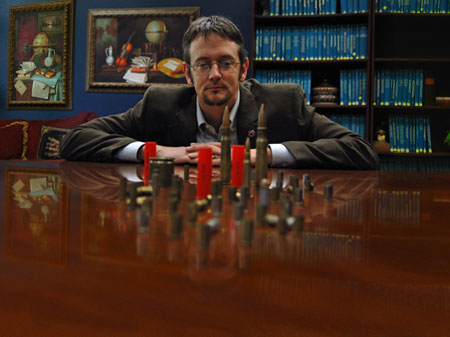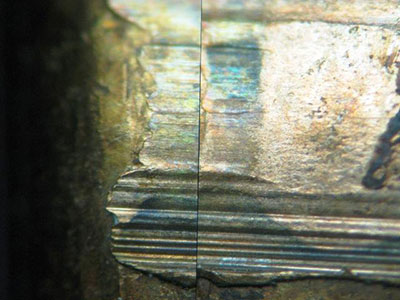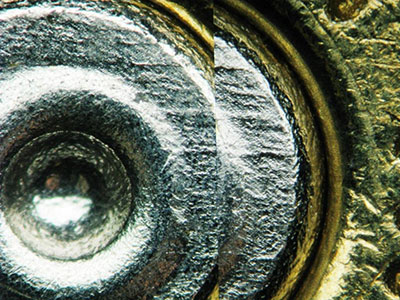Ballistics Study Leads To Federal Agency Changes
Jan. 10, 2014
SHSU Media Contact: Beth Kuhles
 |
| William King completed a study of the NIBIN system for the National Institute of Justice. —Submitted photo |
A team of researchers led by Sam Houston State University identified a number of areas of improvement in a national database of forensic ballistics evidence used to link guns to violent crimes.
The report, released in December by the National Institute of Justice, already has led to improvements in the system called the National Integrated Ballistic Information Network, which is operated by the Bureau of Alcohol, Tobacco, Firearms and Explosives.
NIBIN is the only nationwide database that allows for the comparison of ballistics evidence in criminal cases, either to assist in identifying a suspect or to link firearms to different crimes. Firearms examiners at state and local crime laboratories compare tool marks on fired bullets or cartridges found at a crime scene to digitized images of ballistic evidence in the nationwide, NIBIN database.
“NIBIN has tremendous potential to help criminal investigators solve violent gun crimes and combat organized criminal groups that use guns to commit violent crimes and homicides,” said William King, associate professor of criminal justice and principal investigator of the study. “Historically, NIBIN has suffered from a lack of funding and clear performance metrics that can be used to assess how well the program is working.”
The study, funded by the National Institute of Justice, found that criminal investigators rarely used the ballistics reports to link weapons used in multiple crimes because they were delivered after the investigation had concluded. The NIBIN system, which encompasses 150 local police agencies and crime labs across the country that analyze bullets and cartridges markings, took an average of 101 days to produce reports.
King said that there was a wide variation in performance among the NIBIN sites, but that some labs, such as those at the Houston and the Santa Ana, Calif., police departments, had developed exceptionally quick processes to assist in criminal cases, despite the considerable number of gun cases they process each year.
 |
| Matching bullet (above) and a matching a cartridge case fired from a Beretta 92D (below). |
 |
Among the extensive recommendations made in the study were to expand the information available on NIBIN “hit” reports to include geographic codes and criminal records data; create standardized measures beyond the number of inputs and hits for evaluating the performance of local NIBIN sites; and establish an ATF research and development program to determine innovative practices among NIBIN sites, particularly those that would remove impediments to timely identification of hits.
In response to early drafts of the research report, in 2012, ATF began taking steps to improve oversight and performance of NIBIN.
“ATF has made a focused effort to move the NIBIN program from a stand-alone laboratory tool to a fully integrated component of crime gun intelligence,” said Ron Turk, ATF assistant director of field operations. “The singular mission of NIBIN is to reduce firearm violence through aggressive investigation and prosecution of criminal shooters. This NIJ report validates many of the changes ATF has implemented in the NIBIN program over the last year in an effort to achieve our mission.”
The study also recommended that NIBIN be used as a strategic tool to identify and combat gun crime activities by organized crime groups, such as gangs, by expanding the information available on NIBIN to investigate key players in these crimes. That information includes geographic codes, the names of suspects and victims, possible gang affiliation or other pertinent relationships.
“When ballistic hit reports are organized as a network analysis, it is possible to identify and target the key nodes in a criminal network,” King said. “In the past, ATF has conducted these strategic analysis activities for some local agencies, but we are suggesting a program that is more wide-spread, more systematic and that used advanced software and analysis.”
“NIBIN can make American communities safer from violent gun crime,” King said. “Our report highlights areas where the program can be strengthened and improved at the local level of crime labs and police agencies and nationally with ATF. ATF has already taken numerous steps to improve the performance of NIBIN in response to our preliminary findings and our final report.”
The study was conducted by researchers at SHSU, Arizona State University, American University, and the University of Cincinnati. The full report, “Opening the Black Box of NIBIN: A Descriptive Process and Outcome Evaluation of the Use of NIBIN and its Effects on Criminal investigation,” is available at http://tinyurl.com/my3tsbm.
- END -
This page maintained by SHSU's Communications Office
Associate Director: Julia May
Manager: Jennifer Gauntt
Located in the 115 Administration Building
Telephone: 936.294.1836; Fax: 936.294.1834
Please send comments, corrections, news tips to Today@Sam.edu.

 SamWeb
SamWeb My Sam
My Sam E-mail
E-mail

